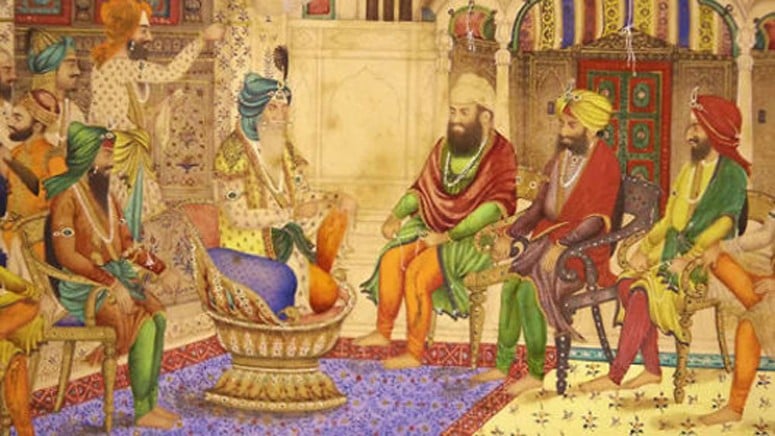
Geopolitical challenges that confront Pakistan are uncannily similar to those that the Sikh kingdom faced from 1799 till 1849

The nature of geopolitical challenges that confronts Pakistan is uncannily analogous to those that the Sikh kingdom faced during the half century of its existence from 1799 till 1849.
In the period leading up to the outbreak of the First Anglo-Sikh War in December 1845, the set of threats that jeopardised the Sikh kingdom’s security consisted of the insatiable expansionism of the British East India Company on the eastern borders of the kingdom and the hostile Afghans on the western borders. In the case of Pakistan, an aggressive India is itching for mischief in the east, while a fragile, restive and an unreliable Afghanistan affects Pakistan’s security in the west.
Sikh kingdom was a more or less status-quo power that was confronted with the revisionism of the British East India Company. Similarly, Pakistan has no expansionist regional agenda but has had to bear the brunt of the regional hegemonic revisionism of India.
Afghan-Sikh relations were based on competition but had had a room for mutual accommodation. Relations between Islamabad and Kabul have also been largely tense but have witnessed collaboration against common challenges from time to time.
While the external threats loomed large, the internal affairs of the Sikh kingdom were characterised by internecine factionalism among the ruling elite. Factional fragmentation is also a feature of Pakistan’s political system.
Just as the British East India Company was unsettled by the military prowess of the Sikhs and the resources commanded by their kingdom, so have the Indians always been troubled by the strength of the armed forces of Pakistan and the country’s substantial development potential, augmented, especially as a result of the continuing progress on China-Pakistan Economic Corridor (CPEC)
The British colluded with Afghans who were the suzerains of Sindh as a containment strategy for an increasingly self-assured Sikh kingdom. The province was annexed in 1843 to prepare the ground for the eventual military showdown with the Sikhs two years later. The contemporary Indo-Afghan nexus also smacks of that bygone collaboration to upstage a current common strategic competitor.
Acquiring Sindh was important for the British as part of their struggle against the Sikhs for regional strategic dominance. In like manner, Karachi was and is the target of inimical forces, given its critical importance for the economic prosperity of Pakistan.
Knowing the strategic significance of Jammu and Kashmir, the British were determined to end Sikh rule over the state. They, therefore, schemed with Gulab Singh, the Dogra prime minister of the Sikh Kingdom. Having first managed to force the vanquished Sikhs to cede the state to them, the British later sold it to Gulab Singh in 1846 for almost half the amount of the indemnity they had demanded from the Sikhs.
The dubious, hasty, and illegal actions of the Indians in 1947 can be seen in retrospect as desperate efforts to prevent Kashmir joining Pakistan. The recent Indian measures in Indian-Occupied Kashmir seem to be born out of the same age-old desperation.
Had Kashmir not been made an independent state by the British, it would have become a part of British India as other Sikh dominions did, and, then, would have become a part of Pakistan in 1947 through the application of the majoritarian principle of partition.
One of the strongest sources of stability of the Sikh rule was the generally collaborative and peaceful relations among different segments of the population of the kingdom. Similar peaceful co-existence has marked social relations of the peoples of Pakistan. This is starkly different from the deep communal, ethnic, and social polarisation in India which has now reached insanely high levels under the current Indian regime.
A few fundamental differences between the Sikh kingdom and Pakistan can also prove instructive. The first difference is the degree of state-society cohesion. Although, there was social peace in the Sikh kingdom, the majority of its population, which was Muslim, was largely indifferent to the changing fortunes of the Sikh state. The peoples of Pakistan, on the other hand, are highly responsive to and deeply interested in the welfare of their country and state, as demonstrated by their willing support of the state and self-mobilisation in the face of domestic crises and foreign threats.
The second difference is the geographical endowment. The Sikh kingdom was a landlocked entity, easy to contain and subdue. Keeping it land-locked was, perhaps, the reason that the British East India Company wanted to prevent Sindh from becoming a Sikh dominion. Pakistan, on the contrary, is geographically diverse and cohesive.
The third difference is the geopolitical isolation. Sikh kingdom faced regional isolation and lacked the support of other regional players. It faced a ruthless world of self-help. Pakistan, on the other hand, does not suffer from geopolitical isolation. However, the principle of self-reliance is as relevant now as it was back then.
The fourth major difference is the state of morale, preparedness, and integrity of the armed forces. While the Sikh army had become demoralised and disorganised by the time it encountered the forces of the East India Company in 1846, the armed forces of Pakistan enjoy high levels of morale, discipline, readiness, and public support.
In sum, these demographic, geographic, geopolitical, and strategic differences mean that Pakistan will endure in the long-term where the Sikh kingdom failed.